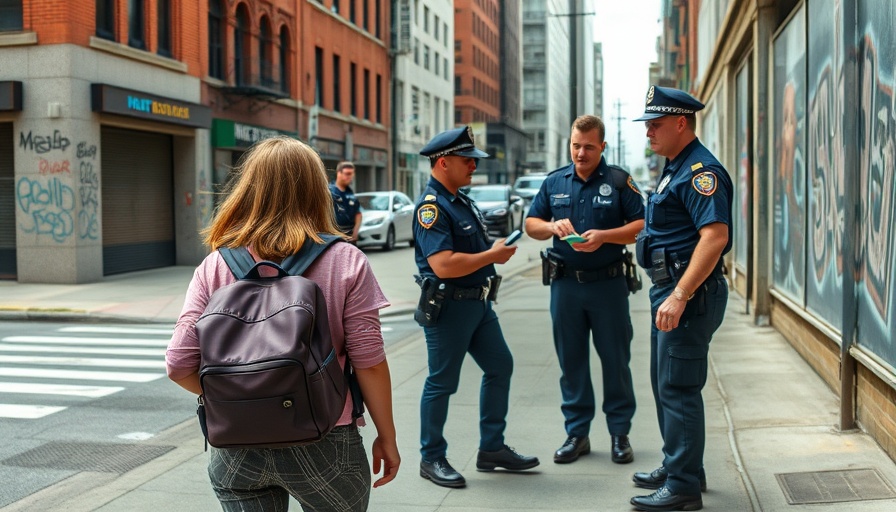
Understanding the 16th Street Crackdown: A Community's Struggle for Safety
As the 16th Street Plaza crackdown enters its 64th day, residents are grappling with an unsettling reality. While the increased police presence aims to address public safety, it raises complex questions about how effectively these measures can truly improve the conditions of the plaza for everyone. Community members, such as Guadalupe Macias, who has operated Don Rafa’s Cyclery for nearly two decades, have noticed a mix of minor improvements overshadowed by persistent challenges around cleanliness and unhoused individuals in the area.
Maciás observes that, despite heightened vigilance from the SFPD, the struggle with trash accumulation remains constant. “In the morning it’s clean, and in the afternoon it’s back,” she notes, highlighting that while attempts to sanitize the area are made, they often fall short. This ongoing litter issue compounds the visible struggles of people who are unhoused, who navigate through the plazas daily, relying on these spaces for shelter and survival.
The Human Impact: Balancing Community Feelings
This crackdown isn't just about law enforcement—it reflects the deep-seated social dynamics at play in urban settings. Residents and business owners are often caught in a conflict of interest: They desire a clean and safe public space, yet they express concern over the treatment of those who lack housing. For example, Macias recalls her encounters with unhoused individuals entering her store, seeking supplies or simply trying to seek refuge from the streets. “I try to be gentle and ask them ‘please leave,’” she says, indicating her struggle to find a balance between compassion and her business needs.
This environment can steer parents and families away from the plaza, changing the social fabric in ways that community networks feel acutely. As these spaces transform under the pressure of law enforcement interventions, they risk fostering an atmosphere of fear for those who simply wish to shop, socialize, or seek services.
Gathering Voices: Community Meetings Reflecting Diverse Perspectives
The situation has prompted responses from the community, highlighted by two evening gatherings that took place yesterday. A community coffee outside the 16th and Valencia streets parklet aimed at fostering dialogue about the ongoing issues. Meanwhile, a community conversation at Manny’s sought to bring together diverse voices to discuss solutions inspired by neighborhood initiatives. These gatherings embody a collective frustration but also a willingness to explore constructive ways forward.
Community meetings highlight the importance of resident input in shaping city policies. When voices from the community come together, they can push for changes that can lead to more effective solutions and support systems for the unhoused. These conversations serve as a catalyst for residents to share their experiences and advocate for their needs, which can resonate powerfully with local decision-makers.
Future Predictions: Can Policing Solve the Housing Crisis?
Looking ahead, one must consider whether policing can truly eliminate the issues that plague urban centers like San Francisco. While temporary crackdowns may yield short-term cleanliness, the underlying problems of housing insecurity and mental health often persist. Many experts argue that more proactive and compassionate measures are necessary—initiatives that prioritize affordable housing, mental health resources, and the collaboration between social services and law enforcement.
Historical trends in urban policy suggest that those facing homelessness are often pushed into less visible areas in response to crackdowns, only to re-emerge again elsewhere, perpetuating a cycle of avoidance rather than resolution. The city will need to adopt comprehensive solutions that address the root causes head-on, rather than just the symptoms on the surface.
Impact on Local Businesses and Community Life
Local businesses in the 16th Street area are at a crucial crossroads. With fluctuations in safety and cleanliness impacting foot traffic, the economic viability of establishments like Macias’s bike shop comes into question. Owners fear that potential customers might be reluctant to visit areas perceived as unsafe, inadvertently harming small businesses.
This dynamic emphasizes the necessity for the city to balance enforcement with community development. Solutions should involve partnerships with local businesses to create safer environments while supporting unhoused individuals with the services and resources they need. Encouraging local engagement and investment in community projects could promote positive, sustainable developments.
Conclusion: Moving Towards Collective Solutions
The challenges faced by the 16th Street Plaza community highlight a broader struggle that many urban centers encounter. As the crackdown continues, it becomes increasingly evident that simple policing is not a panacea to these complex issues. It’s time for community members, local businesses, and city officials to work together to craft solutions that respect the dignity of every individual while ensuring the safety and vibrancy of the community.
We encourage all residents to participate actively in community discussions and advocate for comprehensive strategies that include equitable solutions for housing and support services. Your voice matters; shaping the future of our public spaces collectively is the key to creating the safe environments we all desire.
 Add Row
Add Row  Add
Add 




 Add Row
Add Row  Add
Add 

Write A Comment